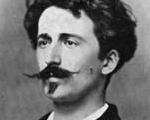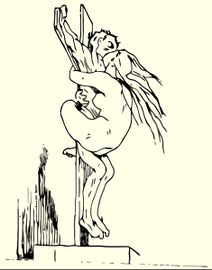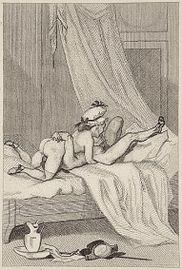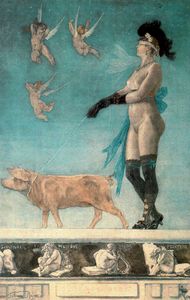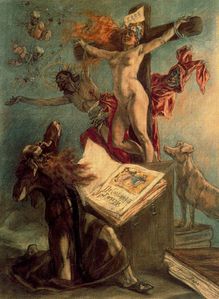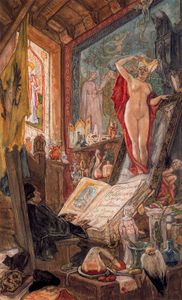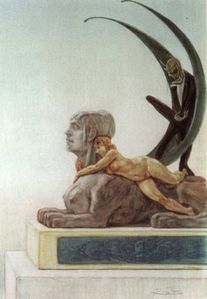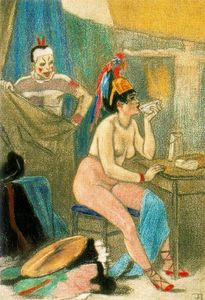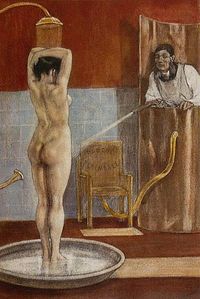Felicien Rops
Félicien Rops (7 July 1833 - 23 August 1898) was a Belgian artist and printmaker in etching aquatint and other techniques. Rops was born in Namur in 1833, and was educated at the University of Brussels. Rops's forte was drawing more than painting in oils. He first won fame as a caricaturist.
Félicien Rops created artwork with sexual and erotic subject matter, as well as dark subjects such as death and satanism. He was the teacher of the Belgian artist Martin van Maële (1863? - 1926), who created illustrations for spanking novels in the beginning of the 20th century.
Later career in Paris (1871–1898)
The extended months in Paris away from his wife, and his poorly concealed extramarital affairs (described by his biographer Patrick Bade as his "careless contempt for bourgeois family values") took a toll on Rops's marriage by the early 1870s. His wife Charlotte wrote to him in a letter: "Your latest despicable affair, the eighth since I met you and we were married, was your way of punishing others, you killed me! Since you don't want to see me any more and asked me not to write to you any more, I want my last word to you to be a word of pardon". One of his mistresses — Alice Renaud, the woman referred to in his wife's letter — was murdered by her jealous husband a few years later, and Rops was involved in the scandal when his intimate love letters to her were read out loud at her husband's trial. Although they never divorced, by 1875 Félicien and Charlotte were permanently estranged and Paris was to be his home for the remainder of his life.
However, far from being disheartened, he thrived among the Parisian artists and poets and his critical reputation grew. There was a greater demand than ever for his illustrations in the last quarter of the 19th century by the publishers and authors of the literary vanguard. Rops was prolific and achieved financial success, boasting in 1877 that "he was the best-paid illustrator in France." He traveled extensively throughout Europe, ranging from the capital cities and art centers, to salmon fishing in Norway and Sweden, back country ventures in Hungary, as well as Spain and Northern Africa. Rops frequently exhibited at the various salons in Paris where the public was both fascinated and shocked by his art and his personal life.
In the 1860s Rops had developed an acquaintance with a Madame Duluc and her two young daughters, Aurélie and Léontine Duluc (age 14 and 17 respectively at that time). A few years later, not long before the estrangement from his wife, he began a ménage à trois with the sisters, apparently with their mother's endorsement. He had children with both, although one child died at an early age; the other, Claire, daughter of Léontine Duluc born in 1871, went on to marry the Belgian author Eugène Demolder. The Duluc sisters ran Maison Duluc, a successful fashion house in Paris, for which Rops designed logos and provided advertisements. The three traveled together to the United States and Canada on two occasions to present their fashions. At least one of the sisters served as a model on occasion, one example being the figure illustrated in Georges Camuset's Sonnet du Docteur (The Sonnets of the Doctor; 1884). The three lived together for over 25 years, until Rops's death. They ultimately settled in a house he purchased, La Demi-Lune, on the River Seine in Corbeil-Essonnes south of Paris, where Rops continued his passion for botany and developed new varieties of roses in later years. Aurélie and Léontine often combined their names, signing Auréléon in their letters and correspondence with Rops.
Rops was invited to join Les XX or Les Vingt, a group of Belgian artists formed in 1883 which held annual exhibitions and concerts at the Palais des Beaux-Arts and the Museum of Modern Art of Brussels. Founders of the Les Vingt included James Ensor, Théo van Rysselberghe, and Fernand Khnopff among others and were later joined by Anna Boch, Jan Toorop, Odilon Redon, and Paul Signac. Their intention was to protect "true originality" and provide a place "where people are free, not only in fact but above all in thought." For 10 years Les Vingt championed the work of progressive artists and composers of the time including many of the Impressionists, Post-Impressionists, Pointillists, and Symbolists.
The French poet Stéphane Mallarmé held Tuesday evening discussions on the arts and literature at his home on 87 Rue de Rome in Paris. These talks became a place of pilgrimage attended by dozens of writers and artists of the time including Rops, Paul Gauguin, J.K. Huysmans, Edward Manet, Edvard Munch, Odilon Redon, Paul-Marie Verlaine, and Emile Zola. He maintained his literary associations to the end of his life and in 1896 the literary revue "La Plume" published a special edition tribute volume devoted exclusively to Rops where many of the prominent authors and artists such as Puvis de Chavannes, Joris-Karl Huysmans, Octave Mirbeau, Josephin Peladan, and Jose-Maria De Heredia praised and celebrated his work. Félicien Rops was a freemason and a member of the Grand Orient of Belgium.
Due to an accident with "bichlorate of potassium" in 1892, Rops almost lost his eyesight but he eventually recovered. With his health slowly deteriorating and anticipating legal challenges from his estranged wife Charlotte, his son Paul, and father-in-law, a judge in Belgium, he made a will in July 1896 leaving everything to the Duluc sisters. He spent some time in the south of France with its milder climate on a doctor's orders but it provided only a little relief. In time, legal issues did arise and the Duluc sisters successfully disputed Paul's attempts to have his father removed from their care, but compromise settlements were made on other issues. Rops died on 23 August 1898 at his home, with Aurélie and Léontine Duluc, his daughter Claire, and some close friends at his side. When notified of his imminent death, Paul traveled from Belgium, but arrived too late to see his father alive. Rops was buried in Essonnes but his body was moved to the family burial grounds in Namur, Belgium eight years later. The following year, he was posthumously awarded the Légion d'honneur.
There is now a Museum, Musée Félicien Rops, in his home town of Namur, Belgium, housing approximately 3,000 engravings and 500 drawings and paintings. Rops also was a gifted and prolific writer of letters. Referring to Rops, Edgar Degas told Manet "That one writes even better than he engraves [...]. If they ever publish his correspondence, I’ll sign up for a thousand copies of propaganda” The Félicien Rops Museu has documented and indexed over 4,000 letters so far, over half are currently available online (see External Links below). His correspondences serve as valuable documents and references, not only for Rops and his work, but for the numerous artists, writers, publishers, and other notable culture figures of late 19th century Europe. The biographers of Baudelaire have drawn from Rops's letters extensively.
Illustration of the sex position "69", published in ‘‘Le Diable au Corps ‘‘ (1865).
all-art.org website Updated: 08/2020 |
Félicien Rops was a Belgian painter and printmaker. The son of a textile manufacturer, he began his artistic education at the local art academy. At the age of 20 he went to live in Brussels where he frequented the Académie de Saint-Luc and practised lithography. His caricatures of political and other public figures and his satires of middle-class life were first published in the student paper Le Crocodile and then in the magazine Uylenspiegel, for which he worked until 1862, contributing two lithographs a week in 1856, but fewer in the following years. His models were mainly Gavarni and Daumier, but in The Waterloo Medal (1858) one can trace the influence of Gillray, while his impressive L’Ordre règne à Varsovie (1863) was obviously inspired by his French predecessor, Grandville. Rops sometimes preferred to use etching (then coming back into fashion) for his illustrations. He made four etchings for Charles de Coster’s Flemish Legends (1858) and five for his Tales from Brabant (1861). In 1862 he visited Paris where he worked with two of the leading etchers of his time, Félix Bracquemond and Jules Jacquemart. He concentrated increasingly on etching and from about 1865 abandoned lithography altogether.
- Felicien Rops
Links
- More information is available at [ Wikipedia:Felicien_Rops ]
Chat rooms • What links here • Copyright info • Contact information • Category:Root
